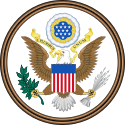Charles Warren Fairbanks
| ||
 Wiceprezydent Charles Fairbanks | ||
| Data i miejsce urodzenia | 11 maja 1852 Unionville Center | |
| Data i miejsce śmierci | 4 czerwca 1918 Indianapolis | |
| 26. wiceprezydent Stanów Zjednoczonych | ||
| Okres | od 4 marca 1905 do 4 marca 1909 | |
| Przynależność polityczna | Partia Republikańska | |
| Druga dama | Cornelia Cole Fairbanks | |
| Poprzednik | Theodore Roosevelt | |
| Następca | James Sherman | |
Charles Warren Fairbanks (ur. 11 maja 1852 w Unionville Center, Ohio, zm. 4 czerwca 1918 w Indianapolis) – amerykański polityk, działacz Partii Republikańskiej, 26. wiceprezydent Stanów Zjednoczonych.
Urodził się w chacie z bali w okolicach Unionville Center, Ohio. Można przypuszczać, że jest spokrewniony z Oliverem Cromwellem. Jonathan Fayerbankes, pierwszy członek rodziny przybył do Ameryki w 1636. Jego ojciec tworzył wagony, rodzina zajmowała się ukrywaniem zbiegłych niewolników. Po ukończeniu lokalnych wiejskich szkół i pracy na farmie, Fairbanks studiował na Ohio Wesleyan University, który ukończył w 1872. Podczas studiów współpracował przy prowadzeniu szkolnej gazety z Cornelią Cole, swoją przyszłą żoną.
Fairbanks był agentem Associated Press w Pittsburghu w Pensylwanii. Pracował dla znanego magnata prasowego Horace’a Greeleya podczas wyborów prezydenckich 1872. Następnie Fairbanks przeprowadził się do Cleveland w Ohio, gdzie uczył się prawa przed zostaniem członkiem ławy przysięgłych lokalnego sądu w 1874. Później przeniósł się do Indianapolis w Indianie.
W początkowych latach życia w Indianie Fairbanks był menadżerem bankrutującej kompanii kolejowej Bloomington and Western Railroad, zarabiał rocznie 5 tys. dolarów.
W latach 1897-1905 był członkiem Senatu Stanów Zjednoczonych. Został wyznaczony jako kandydat Partii Republikańskiej na wiceprezydenta przy kandydującym na prezydenta Theodore Roosevelcie w 1904; po zwycięstwie wyborczym sprawował ten urząd przez jedną kadencję (od 4 marca 1905 do 4 marca 1909). W 1916 ponownie został kandydatem na wiceprezydenta (przy Charlesie Hughesie) jednak zostali oni pokonani przez urzędujących prezydenta i wiceprezydenta Woodrow Wilsona i Thomasa Marshalla.
Linki zewnętrzne
- Biografia w Biographical Directory of the United States Congress (ang.)
- Biografia Senat Stanów Zjednoczonych (ang.)
Media użyte na tej stronie
Charles W Fairbanks
Logo of the Connecticut Republican Party
Seal of the Vice President of the United States. The blazon is defined in Executive Order 11884 as:
The design is the same as the Seal of the President of the United States, except that there is no ring of stars, the clouds are gray (instead of proper), the stars are gray (instead of argent), the scroll is gray (instead of white), the arrows are gray (instead of proper), and the background colors and inscription (obviously) differ.The Coat of Arms of the Vice President of the United States shall be of the following design:
SHIELD: Paleways of thirteen pieces argent and gules, a chief azure; upon the breast of an American eagle displayed holding in his dexter talon an olive branch proper and in his sinister a bundle of thirteen arrows gray, and in his beak a gray scroll inscribed "E PLURIBUS UNUM" sable.
CREST: Behind and above the eagle a radiating glory or, on which appears an arc of thirteen cloud puffs gray, and a constellation of thirteen mullets gray.
The Seal of the Vice President of the United States shall consist of the Coat of Arms encircled by the words "Vice President of the United States."
Signature of Charles Fairbanks.








